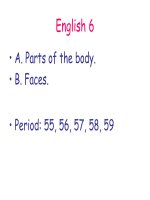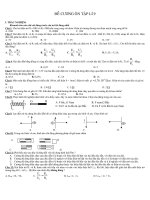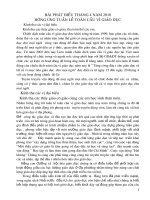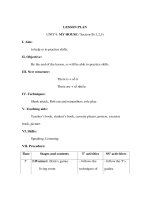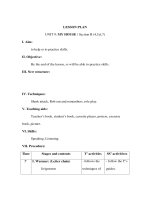preparing date dec3 th 08 nguyôn b¸ h¬ng quy chau high school preparing date dec28 th 08 teaching date dec29 th 08 period division 55th unit 9 deserts lesson a reading i aims by the end of the les
Bạn đang xem bản rút gọn của tài liệu. Xem và tải ngay bản đầy đủ của tài liệu tại đây (484.36 KB, 19 trang )
<span class='text_page_counter'>(1)</span><div class='page_container' data-page=1>
Preparing date: Dec,28 th<sub> 08 </sub>
<i> </i>Teaching date: Dec,29 th<sub> 08. </sub>
<i> </i>Period division: 55th
<b>Unit 9</b>
:
<b>Deserts</b>
<b>Lesson A - Reading </b>
<b>I. Aims : By the end of the lesson, students will be able to </b>
read for specific information to understand the passage and express their ideas about the
deserts.
<b>II. Teaching aids: textbook, poster, picture, chalk….</b>
<b>III. Procedure</b>:
<b>Stages</b> <b>T’s activities</b> <b>Sts’ activities</b>
<b>Warm- up</b>
4’
<b>Filling: Fill in the blank with the most suitable word:</b>
A………..…..is a hot, dry sandy place. -> <b>Desert</b>
Class work
<b>Pre- reading</b>
12’
I. Ask and answer the questions:
<i>Suggested answers:</i>
1. dry, few trees, little or no water, little rainfall, few people
and animals live in a desert………
2. camels, scorpions, cactus………..
3. Egypt, Australia, China………..
II. Vocabulary:
- aerial['eəriəl] (adj): trên không
- dune (n) [dju:n]: đụn cát
- stretch (n) [stret∫]:dải đất, dải nước
- aborigine (n) [,ổbə'ridʒini:z]:thổ dõn Úc
- hummock (n) ['hʌmək] đống gũ, đống
- slope (n) [sloup]: dốc, đường dốc
- corridor (n) ['kɔridɔ:]: đường hành lang
- crest (n) [krest] : đỉnh
- spinifex (n) ['spainəfeks] : cỏ lá nhọn sống ở vùng hoang mạc
nước Úc
III. Check vocabulary R & R
Pair work
<b>While reading</b>
21’
Aks pls to ddiscuss and find out the Vietnamese equivalents.
<b>I. Task 1: </b>
Answers:
1. kéo dài, căng ra 6. cồn cát, đụn cát
<i>2. có cát, </i>cú cỏt <i>7. độ dốc, dốc thoai thoải</i>
<i>3. trắc lợng trên không 8. dốc đứng, dốc ngợc </i>
<i>4. Hội địa lý hồng gia Austra 9. gị, đống</i>
<i>5. thổ dân Australia 10. đỉnh (gò/đống)</i>
<i>11. cỏ lá nhỏn mọc trên hoang mạc</i>
II. Task 2: True- false
<i>Answers:</i>
1. F 2. F 3. T 4. F 5. F 6. T
III. Task 3: Answer the question.
Group work
</div>
<span class='text_page_counter'>(2)</span><div class='page_container' data-page=2>
<i>Answers:</i>
1. They are Great Victoria Deserts, Gibbon, Great Sandy
and Tanami Deserts and Simpson Desert.
2. It lies between Lake Eyre in the south, the Macdonnel
Ranges in the north, the Mulligan and the Diamantina Rivers in
the east, and the Macumba and Finke Rivers in the west.
3. In 1845.
4. He was the President of the South Australian Branch of
the Royal Geographical Society of Australia.
5. They took camels across the desert.
6. In the western part, they are short, mostly less than 10
metres high, and in the northern part, they are parallel and are
up to 20 metres high.
7. Two. They are hummock grasses and spinifex
<b>After reading</b>
6’
The story is funny because the American businessman
pretended to misunderstand the interpreter’s question. The
interpreter mispronounced ‘dessert’ (the last course of the
meal) as ‘desert’ (dry, sand stretch of land). The word ‘dessert’
is stressed on the second syllable while the word ‘desert’ is
stressed on the first syllable.
- desert ['dezət] sa mạc
- dessert [di'zə:t] món ngọt (bánh ngọt, bánh nhân hoa quả,
kem) ăn vào cuối bữa ăn; món tráng miệng (cũng
Individual
work
<b>Home work</b>
2’
- Aks pls to prepare leson speaking Whole class
Preparing date: Dec,28 th<sub> 08 </sub>
<i> </i>Teaching date: Dec,29 th<sub> 08. </sub>
<i> </i>Period division: 56th
<b>Unit 9</b>
:
<b>Deserts</b>
<b>Lesson B - Speaking </b>
<b>I. Aims : By the end of the lesson, students will be able to </b>
- Talking about nature features of the deserts.
- Explaining why some thing should be brought along while going across a desert.
<b>II. Teaching aids: textbook, poster, picture, chalk….</b>
<b>III. Procedure</b>:
<b>Stages</b> <b>T’s activities</b> <b>Sts’ activities</b>
<b>Warm up</b>
15’
<b>Naming the pictures</b>
Give out the pictures and the vocabularies relates to the
speaking lesson then ask pls to work in group to name them
(match)
- Eucalyptus [,ju:kə'liptəs] - crocodile ['krɔkədail](con cá
</div>
<span class='text_page_counter'>(3)</span><div class='page_container' data-page=3>
(cây bạch đàn)
- cactus ['kæktəs] (cây x rồng)
- date palm [pɑ:m] (cây ch là)
- grass [grɑ:s] (cỏ)
- frog [frɔg] (con ếch)
- horse (con ngựa)
- buffalo ['bʌfəlou] (con trâu)
sấu)
- camel ['kæməl] (con l. đà)
- fox [fɔks] (con cáo)
- lizard ['lizəd] (con t. lằn)
- rabbit ['ræbit] (con thỏ)
- goat [gout] (con dê)
- sheep [∫i:p] (con cừu)
Eucalyptus cactus date palm grass
frog horse buffalo crocodile
lizard rabbit camel sheep
fox
Individual
work
<b>Pre - speaking</b>
23’
<b>Task 1: * Checking the trees and animals that might exist </b>
<b>in a desert.</b>
<b>- Ask pls to work individual and compare with a partner.</b>
<b>- Eucalyptus</b> - buffalo - horse
- cactus - crocodile - rabbit
- date palm - camel - goat
- grass - fox - sheep
- frog - lizard
Individual
pair work
<b>* Explain the choice.</b>
- Ask pls to explain the reasons that they choose.
<i><b>Model:</b></i>
</div>
<span class='text_page_counter'>(4)</span><div class='page_container' data-page=4>
might exist in the desert?
- I think date palms, cactus, grass, camels and lizards can exist
in the desert because they don’t need a lot of water and can
survive under difficult conditions.
- What about banana trees?
- I don’t think they can live in such hot weather. Moreover, we
have never seen banana trees in pictures taken in the desert,
have we?
………
<b>While</b>
<b>speaking</b>
21’
<b>Task 2: </b>
So why can bananas, frogs……exist in the desert? -> climate…
Ask pls to find out as much as many features of a desert as
possible. Using the cues in the text book and the model.
<i><b>Useful expressions:</b></i>
- hot - dry
- little rainfall, much sunshine, few grasses, few animals, few
people, sandy……..
<i>Ex: </i>
A: What do you know about the climate in the desert?
B: It is said that it’s very hot in the daytime but it’s very cold
at night.
A: And please tell me about the rainfall. How often does it
rain here?
B: It rarely rains there so everything is very dry.
A: Are there 4 seasons in the deserts?
B: I am not sure but as far as I can remember in some cold
deserts there are hot summer and very cold winter.
………
pair work
<b>After speaking</b>
10’
Task 3:
<i><b>What are five things you should bring along with you if you</b></i>
<i><b>are going on an expedition across the desert?</b></i>
<b>a. - I think I should bring a knife in case I need food to eat. It’s</b>
also used to protect me from the attack of dangerous animals or
bad people.
- And what about a mosquito net? Would you need one?
- Oh, no. I would have a face net and clothes long enough to
cover my whole body.
- And what else would you need?
- Food is next things because it’s very difficult to find food in
Group work
climate
hot
</div>
<span class='text_page_counter'>(5)</span><div class='page_container' data-page=5>
the desert. I think we should bring as much food as possible
because we could get stuck there.
- Why don’t you bring a cell phone? It could be very helpful if
you got lost. Someone could come and rescue you.
- Are you joking? Do you think there would be telephone
waves/ signals in the desert? And how can we charge the
battery?
………… or
<b>b. </b>
- I will bring water because there is little water and may I amy
die without it.
- I will bring a camel because a camel is the best means of
transport in a desert.
- I will bring food because it is almost impossible to find food
in a desert.
- I will bring a box of match because there is no elictricity in a
desert.
- I will bring a blanket because it is ver cold at night in a desert.
<b>Home work</b>
2’
- Ask pls to write down at home and prepare lesson listening Whole class
Preparing date: Dec,28 th<sub> 08 </sub>
<i> </i>Teaching date: Dec,29 th<sub> 08. </sub>
<i> </i>Period division: 57th
<b>Unit 9</b>
:
<b>Deserts</b>
<b>Lesson C - Listening </b>
<b>I. Aims : By the end of the lesson, students will be able to </b>
- To practice students’ speaking and listening skills.
- To help students to guess the meaning of some words and do the task given in
<b>II. Teaching aids: textbook, poster, picture, chalk….</b>
<b>III. Procedure</b>:
<b>Stages</b> <b>T’s activities</b> <b>Sts’ activities</b>
<b>Warm up</b>
6’
- Asks Ss to discuss some questions.
1. What is desert?
2. How is a desert formed?
3. Can human beings make a desert? Why/Why not?
1. It is hot, dry and sandy place. It is a beautiful land of silence
and space. The sun shines, the wind blows and time and space
seem endless.
</div>
<span class='text_page_counter'>(6)</span><div class='page_container' data-page=6>
2. It is formed by natural and human beings.
3. Yes, we cut down the trees and destroy the environment.
Gradually the land will become desert. / Human beings can
contribute in the making of desert because we cut down trees
and destroy forests. These actions can lead to the changes of
climate
Lead in <i>"<b>Our lesson today will focus on some features of </b></i>
<i><b>deserts and how they are formed </b></i>"
<b>Pre</b>
<b> Listening</b>
6’
<b>Listen and repeat</b>
- Ask Ss to listen to the T’s pronunciation and repeat
- frightening speed ['fraitniη spi:d]:tốc độ kinh khủng
- Sahara (n): sa mạc Sahara
- petroleum (n) [p'troulim] dầu mỏ
- Australia (n) [ɔs'treiljən] - firewood (n) ['faiəwud]:cñi
- Mauritania
- phenomenon [fə'nɔminən] hiện tượng
<b>While</b>
<b>Listening</b>
23’
<b>Task 1: True or False statements</b>
<b>* True / false prediction.</b>
- Ask pls to predict the keys in pairs
- Call some to tell their prediction
<b>* True / false prediction check.</b>
- Turn on the tape and ask students to listen to the tapes 2 times
- Call some to check
<i><b>Answers:</b></i>
1T 2T 3T 4F 5T
<b>Task 3: Fill the missing words.</b>
- Give out the words ask pls to find out the missing words and
then fill the words in the blankets
prevent canals smaller plants
spreading 90% capital
- Turn on the tape again and ask students to fill the gaps
- Call some to check
1. 90% 2. smaller plants 3. prevent
4. spreading 5. capital 6. canals
Pairs work
<b>Post</b>
<b>Listening</b>
8’
- Ask pls to summerise the main point of the content
<i>Suggested answers:</i>
- It is hot, dry, sandy place. Also a beautiful land of silence
and space. The sun shines, the win blows and time and space
seem to be endless. Only trees with hard needles can grow in
the deserts.
- Nature and humans contribute to the growing of deserts.
</div>
<span class='text_page_counter'>(7)</span><div class='page_container' data-page=7>
Human beings cut down trees for firewood. When the trees are
gone, smaller plants die and there is nothing but sand and the
land turn into desert.
<b>Home work</b>
2’
- Ask pls to prepare the writing lesson Whole class
<b>DESERTS</b>
Hello everyone. In today's talk, I'm going to tell you something about deserts, what
they are and how they are formed.
A desert is a hot, dry, sandy place. A desert is also a beautiful land of silence and
space. The sun shines, the wind blows, and time and space seem endless. Nothing is soft. The
sand and the rocks are hard, and many of the plants, such as the cactus, have hard needles
instead of leaves.
The size and location of the world's deserts are always changing. Over millions of years, as
climates change and mountains rise, new dry and wet areas develop. But within the last 100
years, deserts have been growing at a frightening speed. This is partly because of natural
changes, but the greatest desert makers are humans.
In the 19th<sub> century some people living in English colonies in Australia got rabbits from</sub>
England. Today there are millions of rabbits in Australia, and they eat every plant they can
find. The great desert that covers the centre of Australia is growing.
Farming first began in the Tigris-Euphrates, but today the land there is a desert. In dry
areas, people can plant crops on dry and poor land. When there are one or two very dry years,
the plants die, and the land becomes desert.
In developing countries, 90 percent of the people use wood for cooking and heat. They
cut down trees for firewood. But trees are important. They cool the land under them and keep
the sun off smaller plants. When leaves fall from a tree, they make the land richer. When the
trees are gone, the smaller plants die, and the land becomes desert.
</div>
<span class='text_page_counter'>(8)</span><div class='page_container' data-page=8>
Well, that's all for my talk. Thank you for listening..
Preparing date: January,3 th<sub> 08 </sub>
<i> </i>Teaching date:,6 th<sub> 08. </sub>
<i> </i>Period division: 58th
<b>Unit 9</b>
:
<b>Deserts</b>
<b>Lesson D - Writing </b>
<b>I. Aims : By the end of the lesson, students will be able to write about the Sahara deserts.</b>
<b>II. Teaching aids: textbook, poster, picture, chalk….</b>
<b>III. Procedure</b>:
<b>Stages</b> <b>T’s activities</b> <b>Sts’ activities</b>
<b>Warm- up</b>
6’
<b>* Eliciting picture: Identify the Sahara desert on the map.</b>
1. Where is the Sahara desert?
2. How large is it?
3. How is it climate?
4. Name some of the natural features of the Sahara?
5. What kind of animals and plants can live in the desert?
Class work
<b>Pre writing</b>
12
* Vocabulary
- extend (v) [iks'tend] : kéo dài, vơn tíi
- arid (adj) ['ỉrid] : kh« c»n
- oasis (n) [ou'eisis] : ốc đảo, nơi thoải mái
- tableland (n) ['teibllổnd] : bình ngun
- gazelle (n) [gə'zel] : linh d¬ng nhá rÊt dƠ th¬ng, linhd¬ng
gazen
- antelope (n) ['ỉntiloup] : con s¬n dơng
- fox (n) [fks] : con cáo
- jackal (n) ['dổk:l] : chã rõng
<b>* Checking technique: Translation</b>
<b>* The way to write a composition about the Sahara </b>
<b>Desert.</b>
* Tenses used: Simple present
</div>
<span class='text_page_counter'>(9)</span><div class='page_container' data-page=9>
* General Outline of the Description:
- Introduction
- General description:
+ geography (location)
+ area
+ natural features ( climate/ rainfall/ elevation/ trees/
animals)
- Conclusion
<b>While-writing</b>
15’
Ask pls to writing the sentences by putting the verbs in the
blankets in the correct tense.
The Sahara (be) the largest desert in the world. It (be) in the
northern of Africa, East of Atlantic Ocean and the west of the
Red Sea and Iraq. It (lie) largely in Morocco, Algeria,
Tunisia, Libya, Egypt, Mauritania, Mali, Niger and Sudan.
This desert (have) a total area of more than 9,065,000
square kilometers with 1610 kilometers width and 5150
kilometers in length from the east to the west. There (be) a
total absence of moisture so it (be) very dry. It (be) very hot in
summer and extremely cold in winter.
The Sahara (be) on a tableland with an elevation of 400 to
500 meters. It (be) an arid sandy land with few oases but many
large sand dunes.
Very few forms of animal and vegetable life (exist) there. The
main trees which (can be find) there are cacti, the date palms,
and a form of acacia. Only animals like gazelles, antelopes,
foxes, jackals and camels (be)found in this desert.
<b>Sample writing:</b>
The Sahara is the largest desert in the world. It is in the
northern of Africa, East of Atlantic Ocean and the west of the
Red Sea and Iraq. It lies largely in Morocco, Algeria, Tunisia,
Libya, Egypt, Mauritania, Mali, Niger and Sudan.
This desert has a total area of more than 9,065,000 square
kilometers with 1610 kilometers width and 5150 kilometers in
length from the east to the west. There is a total absence of
moisture so it is very dry. It is very hot in summer and
extremely cold in winter.
The Sahara is on a tableland with an elevation of 400 to 500
meters. It is an arid sandy land with few oases but many large
sand dunes.
Very few forms of animal and vegetable life exist there.
The main trees which can be found there are cacti, the date
palms, and a form of acacia. Only animals like gazelles,
antelopes, foxes, jackals and camels are found in this desert.
</div>
<span class='text_page_counter'>(10)</span><div class='page_container' data-page=10>
<b>After writing</b>
10’
- Ask pls to exchange the writing to other pls to check and
give remarks.
- Ask pls to represent the task on board if being asked.
- read the writing to get others’ remarks.
- do as the teacher asked.
Pair work
<b>Home work</b>
2’
- Ask pls to write a composition about Quy Chau. Whole class
<i>Date of preparing:</i>
<i>/..../200</i> <i>..</i>
<i>……</i> <i>…</i>
<i>Date of teaching:…… …/ </i> <i>./200…..</i>
<i>Class:………. </i>
Unit 9
<b>Deserts</b>
<b></b>
<b>---oOo---Period No<sub> 59 - Lesson 5: Language focus</sub></b>
<b>I. Objectives:</b>
<i><b>1. Educational aim:</b></i>
<b> </b> - Full and contracted forms of auxiliaries.
- So, but, however and therefore.
<i><b>2. Knowledge: </b></i>
<i>- General knowledge:</i> Combining the sentences.
<i>- Language:</i> Know how to use so, but, however and therefore.
<i> - New words:</i> Words related to the exercises.
<i><b>3. Skills: </b></i>
- To practise students’ pronunciation and writing skills.
- To help students to be able pronounce the full forms and the contracted forms of
auxiliaries and introduce to them the use of so, but, however and therefore.
<b>II. Method: </b>
- Integrated, mainly communicative.
<b>III. Teaching aids: </b>
- Board, tape, cassette player, chalks, textbook and notebook.
<b>IV. Procedure:</b>
<b>Time</b>
3’
5'
<b>Teacher s activities</b>’
- read some words
- ask Ss to listen and
check if there are
differences between
every two words.
- go around the class
and offer help if
necessary.
- call on some Ss to
give their answers in
front of the class.
- give feedback and
correct answers.
- leads in the new
lesson.
- explain how to
pronounce full and
<b>Content</b>
<b>A. Warm- up: </b>Listen and check if there are
differences between every two words
<i>Suggested answers:</i>
1. he’s - his
2. hill – he’ll
3. there – they’re
4. your – you’re
5. time – I’m
<b>Lead in</b>: Today we’ll learn about the full
form and contracted form of auxiliaries.
<b>B. Pronunciation</b>
I. Presentation 1: The full and contracted
forms of auxiliaries.
<b>Students activities</b>’
- listen carefully.
- check if there are
differences between
every two words.
- some Ss give their
answers in front of the
class.
</div>
<span class='text_page_counter'>(11)</span><div class='page_container' data-page=11>
5’
10’
8’
6’
contracted forms of
auxiliaries.
- play the CD.
- ask Ss to repeat in
chorus and individual.
- ask Ss to work in pairs
to practice reading the
sentences in their
textbook on page 103.
- call on some Ss to
read the sentences
aloud.
- make correction if
needed.
- gives some examples.
- ask Ss to express the
sentences in another
way so that the
meaning stays the
same.
- elicit the use of the
conjunctions from Ss.
- have Ss play the game
“Lucky number”
- check the answers
with the whole class.
- explain the example
carefully.
- ask Ss to work in pairs
to do the exercise
suggested.
- ask Ss to discuss the
answers with their
friends.
- asks some of the
students to do the
exercise orally.
- asks other Ss to give
II. Practice
<b>C. Grammar:</b>
I. Presentation 2: Linking words: but/ so/
however/ therefore
<i>1. It began to rain, <b>so</b> I opened my</i>
<i>umbrella.</i>
<i>2. They were late, <b>but</b> they didn t hurry.</i>’
<i><b>Answers:</b></i>
1. It began to rain, <b>therefore</b> I opened my
umbrella.
2. They were late. <b>However,</b> they didn’t
hurry.
3. <b>Although</b> they were late<b>,</b> they didn’t
hurry.
<b>*The use of the conjunctions</b>
1. Similar meaning to but
E.g.: - <b>Although </b>she is much younger than
me, we get on very well together.
- Her father was extremely angry
with her. <b>However</b>, he didn’t say anything.
2. Similar meaning to so
We use <b>so, therefore, as a result</b> or <b>for</b>
<b>this reason</b> to introduce the result of
something
E.g.: - He was late <b>so </b>he ran to the station.
- It was raining hard. As a result, we
didn’t go out.
II. Exercise 1:
<i>Suggested answers:</i>
1. so 5. so
2. but 6. but
3. so 7. but
4. but 8. so
III. Exercise 2
<i>Suggested answers:</i>
1. but 5. but
2. however 6. However
3. yet 7. however
4. so 8. but
- listen carefully.
- repeat in chorus and
individual.
- work in pairs to
practice reading the
sentences in their
textbook on page 103.
- some Ss read the
sentences aloud.
- listen carefully and
note down.
- express the sentences
in another way so that
the meaning stays the
same.
- do as the teacher
asked.
- some Ss give their
answers in front of the
class.
- play the game “Lucky
number”
- notice the teacher’s
explanation.
- work in pairs: Do the
exercise given in the
textbooks.
- discuss the answers
with their friends then
correct the mistakes
themselves.
- some of the Ss to do
the exercise orally.
- other Ss give
comments.
</div>
<span class='text_page_counter'>(12)</span><div class='page_container' data-page=12>
6’
2’
comments.
- give the suggested
answers if necessary.
- explain the example
carefully.
- ask Ss to work in pairs
to do the exercise
suggested.
- ask Ss to discuss the
answers with their
friends.
- ask some of the Ss to
do the exercise orally.
- ask others to give
comments.
- give the suggested
answers if necessary.
- summarize the main
points.
- assign homework.
IV. Exercise 3:
<i>Suggested answers:</i>
1. therefore
2. so
3.so,
4. therefore
5. however
6. Therefore
7. so
8. However.
<b>D. Wrapping</b>
suggested answers.
- notice the teacher’s
explanation.
- work in pairs: Do the
exercise given in the
textbooks.
- discuss the answers
with their friends then
correct the mistakes
themselves.
- some of the Ss to do
the exercise orally.
- other Ss give
comments.
- take notes of the
suggested answers
- redo exercises.
<b>Unit 9 : Deserts</b>
<b>A. Language skills</b>
<b>Reading:</b>
<b>-</b> To help students gain some knowledge about deserts.
<b>-</b> To help students improve their reading skills: scanning and skimming, guessing the meaning of words in
context.
Students learn words and phrases in terms of deserts
<b>Speaking:</b>
<b>-</b> Students can ask and answer about a picture
<b>-</b> Sts know the deserts in Autralia.
<b> Listening:</b>
<b>-</b> Students can improve their listening skill : they can understand the passage and then they can summarize the
passage that they have listened to.
<b>-</b> Students learn more words and phrases in term of deserds
<b>Writing:</b>
<b>-</b> Students can write a report basing on the information given in the Table of the Sahara desert
<b>B. Language focus</b>
<b>1. Pronunciation:</b>
<b>-</b> Students can use full and contracted forms of auxiliaries.
<b>2. Grammar:</b>
<b>-</b> Students know how to use <i>so, but ,howrever, and therefore</i>
<b>A. Reading</b>
<b>Aims</b>
<b>-</b> To help students gain some knowledge about deserts.
<b>-</b> To help students improve their reading skills: scanning and skimming, guessing the meaning of words in
context.
<b>-</b> Students learn words and phrases in terms of deserts
<b>Aids</b>
- English textbook for students
- English textbook for teachers
- Pictures
</div>
<span class='text_page_counter'>(13)</span><div class='page_container' data-page=13>
<b>Stages</b> <b>Teacher s activities</b>’ <b>Students activities</b>’
<b></b>
<b>Pre-reading</b>
(4min)
<b></b>
<b>While-reading</b>
<b>( 30</b>
<b>min.)</b>
<b>Task 1</b>
<b>( 8 min.)</b>
<b>Task 2</b>
<b>( 10</b>
<b>min.)</b>
<b>Task 3</b>
<b>( 7 min.)</b>
<b></b>
<b>Post-reading</b>
<b>( 11</b>
<b>min.)</b>
- Greet Ss
- Ask students to look at the picture page 91 and ask Ss
to answer some questions:
<i>1 What do you know about deserts?</i>
<i>2 what kinds of plants and animals live in a desert.</i>
<i>3 Name some of the countries which have eserts</i>
- Call a pair to report their discussion
- Introduce the topic:
<i><b> Deserts</b></i>
- Teach some new words: ask students whether they
know the words, if they do not know them, explain in
English then ask them to give Vietnamese equivalents
to check their understanding
<i>-</i> <i>strech</i>
<i>-</i> <i>sandy</i>
<i>-</i> <i>aerial survey</i>
<i>-</i> <i>Royal Giographical Society of Autralia</i>
<i>-</i> <i>dune</i>
<i>-</i> <i>sloping</i>
<i>-</i> <i>hummock</i>
<i>-</i> <i>crest</i>
<i>-</i> <i>spinifex</i>
-- Let the whole class read the new words twice or three
times.
- Call 2-3 students to read new words again.
- Ask students to read the passage in silence
- Ask students to do Task 1: Give Vietnamese
equivalent words to ones given in the passage
-Ask students to discuss the answers in pairs Check Ss’
answer
- Write down the answers on the board
- Let the whole class read the new words twice or three
times.
- Call 2-3 students to read new words again.
- Ask students to do task 2 in pairs
- Go around to supervise students if necessary.
- Ask representatives of pairs to give the answers. If
students’ answers are right, repeat them, if not, give the
right answers.
- Ask students to do task 3 in groups
- Go around to supervise students if necessary
- Ask representatives of groups to answer the questions.
If students’ answers are right, repeat them, if not, give
the right answers
- Ask students to do After you read in pairs, scanning
the text to find information to complete the note.
- Go around to supervise them. Note down the serious
and common mistakes
- Call some pairs to read their note
- Give feedback and correct some serious or common
mistakes.
- Greet teacher
- Listen to the teacher and think about the
topic.
- Answer teacher’s questions in pairs
- Give Vietnamese equivalents
- Read the words
- Read the passage in silence
- Do task 1
- Write down the answers and read the
words
- Do task 2 in pairs
- Give the answers:
1. F
2. F
3. T
4. F
5. F
<i>6 T</i>
- Do the Task in pairs
* Suggested answers:
- Listen to the feedback and correct their
mistakes.
<b>B. Speaking</b>
<b>I. Aims</b>
<b>-</b> Students can ask and answer about some deserts
<b>-</b> Students learn more words and phrases about deserts.
<b>II. Aids</b>
</div>
<span class='text_page_counter'>(14)</span><div class='page_container' data-page=14>
<b>III . Procedures</b>
<b>Stages</b> <b>Teacher s activities</b>’ <b>Students activities</b>’
<b></b>
<b>Pre-speaking</b>
( 5 min.)
- Introduce the lesson:
<i>Today, we learn Unit 9: part B. Speakin g</i>(Write on
the board the title)
- Listen to the teacher and write the title in
their notebooks.
<b>Task 1</b>
- Ask students to look at Task 1
- Ask students to do Task 1
- While students discuss, walk around the class to
guide or supervise them and give them help if
necessary.
- Ask sts to check the trees and animals which can
live in deserts
- Give comments, correct the common mistakes
after they finish.
words explanation
<i>eucalyptus</i>
<i>date palm</i>
- Look at Task 1
- Do Task 1
- Work in pairs and discuss in about 2 minutes.
<b></b>
<b>While-speaking</b>
( 28 min.)
<b>Task 2</b>
Ask sts to find out as many natural features of
adesert as possible .Then compare your note with
the other pairs using the given cues
eg : It is very hot in summer and it is cold in winter
Work in pairs
- Let the whole class read the new words twice or
three times. - Read the new words .
- Do Task 2 in groups
- Call one student to repeat the instruction to check
whether they are clear about what they have to do
- Go around to supervise them. Note down serious
and common mistakes.
<i>Present perfect tense</i>
- One student repeats the teacher’s instruction.
- The others listen to their friends to make
clear about what they have to do.
- Do Task 2
<b></b>
<b>Post-speaking</b>
( 10 min.)
<b>Task 3</b>
<b>Home</b>
<b>work</b>
( 2 min.)
- After about 3 minutes of discussion, call some
groups to report what they have done.
- Ask the others to listen to their friends
- <i>Listen to students attentively and pay attention to </i>
<i>the mistakes they have made</i>
- After students finish, give them comments: correct
some pronunciation mistakes they have made
- Read aloud the words and ask the whole class to
repeat.
- Call 1 pair to role play in front of the whole class.
- Ask the others listen attentively to their friends’
dialogue and give comments or ask questions.
- Call another group if there is enough time.
- Give feedback and correct serious or common
mistakes.
<i>- Prepare a presentation about the information </i>
<i>about other deserts</i>
- Some groups report what they have discussed.
<i>S1 : I choose : food , water , camel , knife, </i>
<i>blanket, </i>
<i>S2 : Ichoose : wter ,car food, camel , blanket.</i>
- Repeat after the teacher.
- One pair to role play in front of the whole
class.
- Listen attentively to their friends’ dialogue
and give comments or ask questions.
- Listen to the teacher and correct the mistakes.
- Listen to the teacher and note down
homework
<b>C.Listening </b>
<b>I. Aims</b>
<b>-</b> Students can improve their listening skill: they can catch detail information from the passage.
<b>-</b> Students can summarize the passage.
<b>II. Aids</b>
- English textbook for students
- English textbook for teachers
- Tapes and cassette
- Handouts
</div>
<span class='text_page_counter'>(15)</span><div class='page_container' data-page=15>
<b>Stages</b> <b>Teacher activities</b>’ <b>Learners activities</b>’
<b></b>
<b>Pre-listening</b>
(6min.)
<b>Warm up:</b>
ask sts to answer the questions
1 What is a desert ?
2 How is a desert formed ?
3 can human beings make a desert ?
Work in pairs
<b></b>
<b>While-listening</b>
(29min.)
<i><b>Task 1</b></i>
- Ask students to listen to the passage the first
time
- Read the passage twice
- Ask some students to give their answers. If their
answers are right, repeat them; if not give the
correct answers.
- Listen to the passage and answer the questions.
* Answers:
<i>1.</i> <i>T</i>
<i>2.</i> <i>T</i>
<i>3.</i> <i>F</i>
<i>4.</i> <i>F</i>
<i>5.</i> <i>T</i>
<i> </i>
<i><b>Task 2</b></i>
- Ask them to listen again the second and the third
time to finish task 2:
- Ask students to discuss the answers to the
questions in pairs.
- Go around to supervise students if necessary.
- Eliciting the answers from students, if their
answers are right, repeat the answers, if they are
wrong, give them the answers:
- If most students do not catch the information for
the questions, let them listen again to the passage
once more.
<i><b>Task 3 </b></i> Ask sts to listen again and fill in the
missing words
- Listen again the third time to finish the task.
- Discuss the answers to the questions in pairs.
- Answer the questions, and correct the wrong
answers.
1. 90 percent
2. smaller plants
3. prevent
4. speading
5. capital
6. canals
<b></b>
<b>Post-listening</b>
(10min.)
- Ask students to do After you read in groups<i> _ </i>
<i>discuss the questions in the book</i>
- Go around to supervise them. Note down serious
and common mistakes.
- Ask one group to report what they have
discussed
- Give comments after they finish
- Call another group if there is enough time.
- Give feedback and correct serious or common
mistakes.
wor in groups
<b>D.Writing</b>
<b>I. Aims</b>
<b>-</b> Students can write a report basing on the information given in the Table of Tango’ economic
development in two decades
<b>-</b> Students can improve their writing skill.
<b>II. Aids</b>
- English textbook for students
- English textbook for teachers
</div>
<span class='text_page_counter'>(16)</span><div class='page_container' data-page=16>
<b>Stages</b> <b>Teacher s activities</b>’ <b>Students activities</b>’
<b></b>
<b>Pre-writing</b>
(7min.)
- Write on the board the title of the lesson: Unit 9
Part D. Writing
- Ask students to look at the table page 96
<i>This table presents the information about the </i>
<i>Sahara resert</i>
- Introduce some new words.( eliciting , give the
definitions in English then ask students to translate
them into Vietnamese to check their
understanding)
arid
moisture
elevation
acacia
Gazelle
jackal
- Write down in the notebooks the title.
- Look at the table page 96
- Listen to the teacher.
- Guess the meaning of the new words.
- Read the words
While-
writing
(28 min.)
- Go around to supervise them if necessary.
- Call some pairs to give the answers. If their
answers are right, repeat them; if not give the
correct answers.
<i>.</i>
<i>Questions </i>
<i>1 Where is th Sahara desert ?</i>
<i>2 Whwt is its total area /</i>
<i>3 How long is it ? </i>
<i>4 How wide is it? </i>
<i>5 What is its natural feature ?</i>
<i>- Land</i>
<i>- Climate</i>
<i>- sand</i>
<i>-Table land</i>
<i>Wal kinds of trees can live in the Sahara desert ?</i>
- Go around to supervise them. Note down serious
and common mistakes
- Show and correct some common mistakes.
- Write the description
- Listen to the teacher and correct the
mistakes.
<b></b>
<b>Post-writing</b>
( 10 min.)
- Ask students to revise their description.
- Ask students to hand in their work to mark - Revise their description.
- Hand in their work
<b>E.Language focus</b>
<b> I. Aims</b>
<b> 1. Pronunciation:</b>
<b>-</b> Students can use the full and contracted forms of theauxiliaries pronunced
<b>2. Grammar:</b>
<b>-</b> Students know how to use “ so , but, however and therefore.
<b>-</b> Students revise information questions.
<b>-</b> Students practice using past tense to talk about people’ autobiography
<b></b>
<b>-II. Aids</b>
- English textbook for students
- English textbook for teachers
- Pictures
<b>III. Procedures</b>
<b>Stages</b>
</div>
<span class='text_page_counter'>(17)</span><div class='page_container' data-page=17>
<b>Pronuncia</b>
<b>tion</b>
(7min.)
- Introduce the lesson:
<i>Auxiliary often has the strong form when it is </i>
<i>used in short answers, and it has the weak </i>
<i>form when it is used in questions.</i>
- Read the auxiliaries both full and contracted
forms for students to recognize the difference
- Read the second time for the students to
repeat.
- Ask 2-3 students to repeat, correct their
mispronounce.
- Listen to the teacher
- Listen to the teacher
- Read the sound
<b>Practice these sentences</b>
- Read 2 times the sentences, and then let the
whole class read the sentences twice or three
times.
- Read the sentences twice or three times.
- Read the sentences again
- Read the sentences in pairs.
<b>Grammar</b>
(38min.) <i><b>Exercise 1</b></i>Explain how to use <i><b>so or but</b></i>
<i>Can you tell me what the difference </i><b>so</b><i> and </i>
<b>but</b><i> ? Give me some example</i>
<i>It began to rain , so I open my umbrella</i>
<i>It began to rain , but he didn"t open his </i>
<i>umbrella</i>
<i> Note : Before " so , but " there is a comma</i>
- Call some students to give their answers. If
students’ answers are right, repeat them, if
not, give the right answers
<i>.</i>
<i><b>Exercise 2</b></i>
Underline the correct altrmative in the sences
Note : xplain how to use <i><b>however</b></i>
- Call some students to give their answers. If
students’ answers are right, repeat them, if
not, give the right answers
Go around to supervise them
<i><b>Exercise 3</b></i>
Add so , therefore , or however
Note The use of <i><b>therefore</b></i>
- Call some students to give their answers. If
students’ answers are right, repeat them, if
not, give the right answers
Go around to supervise them
- Ask students to do exercise 3
- Go around to supervise them
- Ask students to discuss the answers in pairs.
- Call some students to give their answers. If
students’ answers are right, repeat them, if
not, give the right answers
- Give the answers
<i>1 so</i>
<i>2 but</i>
<i>3 so</i>
<i>4 but</i>
<i>5 so</i>
<i>6 but</i>
<i>7 but</i>
<i>8 so</i>
<i>- give the answer </i>
<i>1 but</i>
</div>
<span class='text_page_counter'>(18)</span><div class='page_container' data-page=18></div>
<span class='text_page_counter'>(19)</span><div class='page_container' data-page=19></div>
<!--links-->
